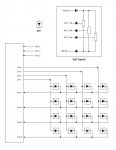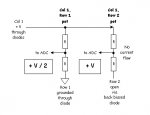Imagine an 18X Led matrix, diodes pointing out on the row drives, diodes pointing in on the column drives; any single Led can be selected by having one row high the others low, one column low the others high, now ...
Replace the nodes with 10K pots, all with their wipers joined feeding a single ADC input via a diode ( giving a 0V to Vpsu-Vdiode input ). That's a 4x4, 16 pot multiplexor. The 18X has three ADC's so let's go for three pots per node, each feeding a separate ADC; a 48 pot multiplexor.
I'm not too worried about a little noise pick-up or having to have some small dead-zone top and bottom to get a 0-255 result from each pot.
Can anyone see any problems I've overlooked ?
Added : I think each pot will need a pair of diodes, one at each end.
Replace the nodes with 10K pots, all with their wipers joined feeding a single ADC input via a diode ( giving a 0V to Vpsu-Vdiode input ). That's a 4x4, 16 pot multiplexor. The 18X has three ADC's so let's go for three pots per node, each feeding a separate ADC; a 48 pot multiplexor.
I'm not too worried about a little noise pick-up or having to have some small dead-zone top and bottom to get a 0-255 result from each pot.
Can anyone see any problems I've overlooked ?
Added : I think each pot will need a pair of diodes, one at each end.
Last edited:


